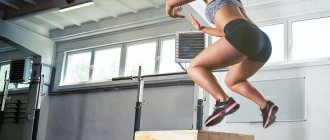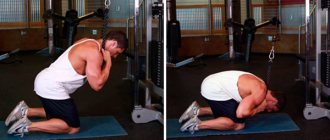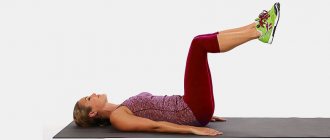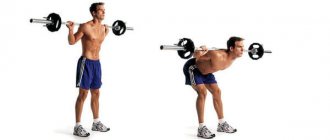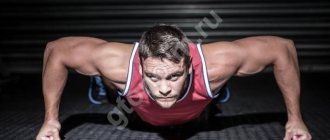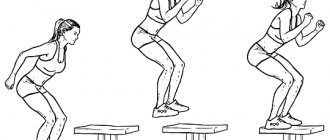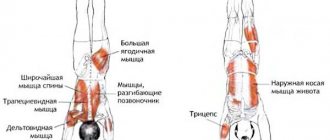Abdominal exercises are done at the end of each workout. But not all, and not always. In bodybuilding, incline crunches are a necessary part of the plan for the beginner and intermediate athlete. Those who have fairly hypertrophied abs usually only “pump up” them with simpler exercises. In other strength disciplines, incline crunches are also used. Strength workers do it to compensate for the deflection in the spine that occurs when squats. Athletes of other disciplines - just to pump up their abs. This popular movement has quite a few subtleties. After all, most athletes do it incorrectly, but solely through the quadriceps and body jerks. But once you learn how to do the twist correctly, you will feel the difference.
Execution technique
Initial position
- Secure your knees to the bolsters of a crunch bench;
- Press your buttocks against the surface of the bench;
- Tighten your stomach;
- Place your hands behind your head;
- Lean back to horizontal
Movement
- As you exhale, contract your abdominal muscles;
- Bring the lower ribs to the pelvic bones;
- Pull your stomach in even more;
- At the peak of the contraction, pause for a moment and then repeat.
Attention
- Technically, some people do a full lift rather than a crunch. They lie down on a bench and, due to the inertia and strength of the quadriceps, lift the body completely. It is not advisable to perform this movement exactly this way, because the press will no longer work in such a technique;
- There is no need to bend your lower back inward to increase the amplitude. This overloads the back and can lead to protrusions;
- Pressing your palms on the back of your head should be avoided. If the pressure is too strong, the cervical vertebrae may be displaced;
- The bench should be adjusted so that the shins do not move too far away from the pads of the machine when lowering the body down.
Recommendations
- The twist is performed by rounding the back rather than by “bringing” the shoulders toward the knees with a strong flexion at the hip joint. Round your spine and roll your shoulders forward;
- Try to follow the principle of “exhale with effort.” The peak contraction at the top point should be performed when there is almost no air in the lungs;
- Work smoothly, avoid jerking, so that the efforts to lift the body become more measured, and the insulation works
It's a PRECIOUS TRUSH, baby.
Execution options
- In a Roman chair . This machine is designed to protect the athlete's back. It is only important that it suits the athlete’s height. It is necessary to ensure that the pelvis does not come off during twisting. The athlete can perform a backbend slightly deeper than a normal crunch;
- Diagonal or cross crunches . In this version of the exercise, we reach with the opposite shoulder towards the hip or knee. This option should work the oblique muscles more. But it does not provide significant hypertrophy, so those who want to have a thin waist can also do it;
- Twisting from a lying position on a bench . This variation is reminiscent of the classic crunch while lying on the floor. A full body lift is not required here. The athlete's goal is to bring the lower ribs to the pelvic bones. You need to pull in your stomach, and gradually bring your ribs to the pelvis, and then lower yourself to the starting position;
- Weighted crunches . They help not only to build muscles, but also to work out the abs in strength mode. The abs are also pumped with weights in order to get “pronounced abs” and muscle hypertrophy.
Possible options for performing crunches on an incline bench
Oblique crunches on an incline bench
Oblique crunches on an incline bench
Crunches with twists help to work the obliques more. It is performed, in contrast to straight twists, with body rotations. You can do it alternately or alternately.
At the top of the exercise's range of motion, try to reach your left elbow toward your right knee as you turn to the right. And vice versa, with the right elbow to the left knee when twisting to the left.
Crunches with additional weighting
Crunches with additional weighting
If the load of your own weight is not enough, you can complicate the exercise. Take a barbell plate and hold it behind your head and in front of you. Choose the position of the pancake as convenient for you. If the pancake is behind your head, the load is greater, if it is in front of you, the load is correspondingly less.
Incline crunches with arm raises
Incline crunches with arm raises
This variation of twisting helps to complicate the usual movements. Also includes the shoulder muscles. You can do it simply by raising your arms. And you can hold additional weight.
With this method of performing the exercise, the abdominal muscles are activated more under static load, and contraction practically does not occur. The front of the thigh takes a significant percentage of the load.
Advice! To diversify your training program, you can try alternating the option with lifts. But the main version of crunches on an incline bench will be more effective for abs.
Short crunches while lying on a bench
Short crunches while lying on a bench
Shortened range of motion, suitable for peak activation of the four upper abs.
Performed while lying on a bench. Twisting occurs only due to the thoracic region. Keep your neck straight, look ahead.
If you need a detailed video of all exercise options? Write to YouTube in the comments to the video posted at the beginning of the article.
Adviсe
- When your arms are held in front of you, the load is lighter. When your hands are behind your head it is more difficult.
- Concentrate on crunches rather than lifts. To master crunches faster, touch your upper abs with your fingers. Check their correct operation while twisting. The muscles must contract.
- Make movements in an arc. Imagine that the shoulder girdle needs to be brought as close to the pelvis as possible.
- Perform movements smoothly, lifting 2 times faster than lowering.
- Breathe correctly. Very important! Breathing plays almost a key role in any twisting. Lower yourself down only after exhaling completely in the upper body position.
Anatomy of exercise - which muscles work
Target working muscle and auxiliary muscles:
- Rectus abdominis muscle
- Quadriceps, obliques, tensor fasciae lata, iliopsoas
Benefits of the exercise:
- Suitable for beginners;
- Allows you to progress and increase the load;
- Not dangerous;
- Has many modifications and options
Flaws
Those who go to an inexpensive gym will have to suffer for quite a long time if their shins are slightly larger than those of the average person. It is not convenient to train on an incline bench for those who have large hamstrings. Such people cannot always adjust a cheap small shop to suit themselves. More professional equipment takes into account the anthropometric characteristics of professional athletes. The second disadvantage is the inability to adequately perform the movement at home. They sell universal benches for the home, but they are only convenient for working out your abs, and not for performing other exercises as well.
Benefits of Exercise
Double twists have the following advantages:
- the abdominal muscles are developed;
- the core muscles are strengthened (the entire muscle corset);
- posture improves and spinal muscles are strengthened;
- endurance for increased loads increases;
- ease of implementation, does not require additional devices;
- you can train at home.
Preparation for execution
You need to set the inclination of the bench to about 30 degrees, and adjust the height of the locking rollers so that your legs are comfortable and your pelvis remains on the bench when lifting. It is necessary to practice lifting onto the bench and develop the starting position.
If the projectile swings from side to side, it is worth strengthening it by placing pancakes on both sides of the legs.
The abs are usually worked out at the end of a workout, and there is no need to warm up before them. If a person has problems with mobility in the hip joints, he should perform circular rotations of the pelvis, abduction of the hips to the side, and bends forward in a volume sufficient to warm up.
Abdominal exercises. Lifting the body.
Proper execution
- The twisting of the spine itself begins at approximately two-thirds of the amplitude, at the top. Lifting is carried out due to the strength of the abdominal muscles, and not due to inertia, “acceleration” of the body with the legs, or contraction of the quadriceps;
- You should not put pressure on the back of your head with your hands. They should either lightly hold the head at the temples, or be extended along the body. It is not recommended to stretch your arms forward, as this contributes to the development of the wrong habit - stretching your chest and neck forward, rather than curling towards your hips;
- The lower back should be kept as flat as possible, not rounded too much;
- There is no need to throw your head back or pull your chin forward;
- You can round your shoulders forward; you don’t need to rise with a straight back;
- At the top of the amplitude, the spine makes approximately a right angle with the femur
Recommendations for effective implementation
- You can increase the load by increasing the angle of the back of the bench. Beginners can start the exercise from an almost flat bench, gradually increasing the angle;
- Additional weights for this exercise are a barbell or medicine ball;
- Static retention at the top point is allowed;
- The super-slow method also increases the load, that is, twisting for 10 counts and the same slow lowering;
- The closer the hands are to the head, the more actively the press turns on. But if you grab your hips with your hands, nothing will work
What muscles are trained?
Let's look at what areas of the muscular system are worked out during double crunches:
- The main load falls on the rectus abdominis muscle, i.e. press. The external oblique abdominal muscles are also included in the work.
- The following muscles receive secondary load: the trapezius lower fasciculus and the serratus anterior muscles. Also involved are the sternocleidomastoid muscles, pelvis, shoulder and elbow joints.
When performing the exercise, special attention is paid to working out the abdominal muscles, so the load should fall to a greater extent on this area of the muscular system. To do this, it is necessary to strictly adhere to the correct technique, so that the remaining specified muscles will receive the least load.
Inclusion in the program
The training program is an individual thing. Many people combine several abdominal exercises in one workout, such as hanging leg raises or lying leg raises. Others believe that there is no particular point in doing 2-3 abdominal exercises. In fact, straight crunches tone the abdominal muscles, and can help with abs if a person has a little body fat. But those who have problems with posture and pronounced lordosis should also do leg lifts.
If a person does a lot of barbell crunches and hyperextensions, it makes sense for him to do leg raises rather than crunches. This will help avoid hypertonicity of the iliac muscle and pain.
In strength disciplines, straight crunches on a bench can be combined with standing crunches, that is, an exercise similar to “prayer”, but performed while standing. Strength athletes should remember that 3-4 approaches with a weight that can be used to perform a twist 5-6 times is quite enough. Six packs, burning sensations and other stories about “beautiful abs” should be left to fitness models. To squat and bench a lot, you need strong abs, not a thin waist.
For those who want to lose weight, doing too many abdominal exercises is also not recommended. 2-3 working approaches to failure at the end of the workout is the required minimum, and it is also the maximum. If you overtrain your abs, they will not become sculpted and beautiful faster. Some bodybuilders do 3-4 working sets of 20 reps, but this is beyond beginner level.
Promo (hall): Crunches while sitting on an incline bench
Incline crunches: video
There are various variations of incline crunches. Can be performed with body rotations, including more oblique abdominal muscles. Can be done with holding and lifting additional weight.
How to do the exercise correctly? Execution technique
- Sit on a bench. Secure your legs tightly under the special bolsters of the bench. Keep the body vertical. Palms of hands near temples. This will be the starting position.
- Lower your body down until it is parallel to the floor. Inhale as you go down.
- From the bottom position, start doing body twists, lifting your body up to the highest possible position. Try to twist the shoulder girdle in an arc towards the pelvis, while simultaneously lifting. At the end of the movement, exhale completely.
- Repeat the movement 15 times for 3 sets.
How to do crunches correctly
Application of the exercise
For whom . Girls and men of any level of training.
When . Incline crunches should be done at the beginning or end of your workout. After crunches, you can do another exercise - hanging knee raises.
How many . The exercise should be done in 3 sets of 15-20 repetitions. It is recommended to rest for about 60 seconds between sets of abdominal muscles.
Contraindications
This exercise is not recommended for any injuries of the hip joints and femoral neck. Back and lower back problems should also be addressed before the client discovers the incline bench. Even simple discomfort in the lower back means that it is better to switch to a fitball, or lying down;
Hypertensive patients should not make the bench angle too high. A significant angle of inclination promotes a rush of blood to the head and can lead to pressure changes;
A bench with a high rise is not recommended for those who have myopia and a tendency to retinal detachment. Such a person should not actively perform exercises in which the head is lower than the chest. Moreover, you should not “strain” when pumping up your abs. It is better to do hanging leg raises with this condition;
The exercise can also be quite unsafe for spinal hernias. If there is no deterioration, the choice of exercises should be discussed with your doctor.

